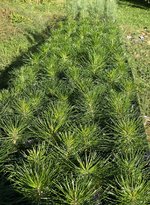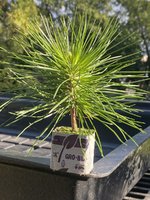You are using an out of date browser. It may not display this or other websites correctly.
You should upgrade or use an alternative browser.
You should upgrade or use an alternative browser.
CM BONSAI!!
- Thread starter cmeg1
- Start date
cmeg1
Imperial Masterpiece
Thanks everyone
HankDio
Yamadori
I didn't need more black pine seedlings, but I was really excited to happen upon this sale and snagged a few! Your stock always looks so vigorous and healthy.
cmeg1
Imperial Masterpiece
Thanks..certainly is a nice price for getting some stock going………these can very well have 10” candles next spring if everything is maintained……proper Autumn sunshine and dormancy phase,ph ,etc.I didn't need more black pine seedlings
NateMcFly3
Seedling
Just ordered 4 - send me some good ones! 
Maiden69
Masterpiece
I am not an expert at all, but I am beginning to think that this dormancy period really applies only to species that are alpine in nature. When I was shopping for some punica I came into many websites advertising the need for XX amount of chill hours necessary, yet my mom had a huge punica tree in her house when I was growing up in Puerto Rico, tropical zone 13 with an average temp of around 78 in the dead of "winter" for a few days. Japanese black pine is very tolerant to the heat, and most coastal areas in Japan are in the zone 10, although they do get lower temps when compared with the zone 10 in the US. The seedlings that I bought from Matt O before I knew you were selling spent their first year out in the rollercoaster of a Texas winter weather, with temps between 20-80 degrees, I did lost 2, but they were not weather related. They are growing strong, like nothing happened and they were not sheltered at all.
I would think that your seedlings have a far better chance of survival than the bareroot strings I received from Matt. The kabudachi JBP I got from you in July last year did awesome this winter as well.
I would think that your seedlings have a far better chance of survival than the bareroot strings I received from Matt. The kabudachi JBP I got from you in July last year did awesome this winter as well.
cmeg1
Imperial Masterpiece
Yeah I’ve seen Japanese black pine growing quite fine in Hawaii.I am not an expert at all, but I am beginning to think that this dormancy period really applies only to species that are alpine in nature. When I was shopping for some punica I came into many websites advertising the need for XX amount of chill hours necessary, yet my mom had a huge punica tree in her house when I was growing up in Puerto Rico, tropical zone 13 with an average temp of around 78 in the dead of "winter" for a few days. Japanese black pine is very tolerant to the heat, and most coastal areas in Japan are in the zone 10, although they do get lower temps when compared with the zone 10 in the US. The seedlings that I bought from Matt O before I knew you were selling spent their first year out in the rollercoaster of a Texas winter weather, with temps between 20-80 degrees, I did lost 2, but they were not weather related. They are growing strong, like nothing happened and they were not sheltered at all.
I would think that your seedlings have a far better chance of survival than the bareroot strings I received from Matt. The kabudachi JBP I got from you in July last year did awesome this winter as well.
The dormancy I was relating to is for the cold winters and be able to have them survive a freezing winter they will do so only if they get the natural sun minimizing and the cold minimizing of autumn into winter for them to survive properly.
I’ve tried refrigerators and everything and the best growth I’ve seen in my cold winters where it does drop quite cold for months at a time and everything does freeze solid is to let them experience the autumn natural sunshine and lite frost preperations.
cmeg1
Imperial Masterpiece
Maiden69
Masterpiece
Awful picture, just realized the glare in it, that's the kabudachi I got from you, pushing another flush unprovoqued from the end of this years candles. They love the 5:2 mix... In fact, all the trees I am using them are breaking buds everywhere without me needing to cut at all.
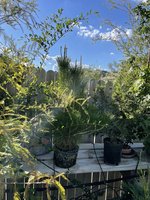

My seiju elm, pushing new growth now. I am speachless on the results from the RAW products!
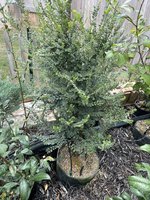
almost 2 feet extension this year. Begging for some wire and airlayer into a twin trunk in the future.



My seiju elm, pushing new growth now. I am speachless on the results from the RAW products!

almost 2 feet extension this year. Begging for some wire and airlayer into a twin trunk in the future.

cmeg1
Imperial Masterpiece
Will you wire the trunk base together with some protective tubing or something?that's the kabudachi I got from you, pushing another flush
Or not needing it?
Thanks…great to see this…….the color has seemed to improve.
Also foliar feed will make nice backbudding……is that what your referring too?
Just once a week.
Guy Smiley
Seedling
What is the 5:2 mix?
cmeg1
Imperial Masterpiece
1/8th tsp fulvic acid powder:1/16th tsp kelp powder.What is the 5:2 mix?
Virginia tech supposedly did a 10 year experiment and found this ratio to work 50% better than either product on its own.
Very good as daily root drench with your fertilizer or once a week with foliar…….black humic powder is good for roots too in this ratio.Fulvic is a low moleculer weight humic acid that can transport growth elements or ions into plant cells whereas the larger moleculer weight black humic acid powder is a great chelator meaning it hold onto growth elements or ions like a claw more or less…….near to the roots and keeps ion from leaching out with watering.
It has been said if your only going to use one bio-stimulant…..kelp is the one.
Fulvic is the choice for foliar as it is small enough to carry elements into leaf cells in as little as 4 hours it has been scientifically noted.
Black humic is also a wonderful filler for pure and ro type water as it puts mineral back into pure water that would otherwise draw ions right out of the roots and have a negative effect….namely in hydroponic inert media.
Maiden69
Masterpiece
When I did that partial clean up a few weeks ago I tried cleaning between the trees on the soil and there is no space at all... so I am pretty sure the base is entirely fused together. I plan on repotting this spring into a box probably or a large #7 but shallow rootpouch and attempt to wire the trunks to give them some movement. Right now they are all pretty straight. Thankfully they have not thicken equally and there is one that will definitely be the main trunk. I will probably leave that one grow before cutting one or two more years just wiring and shaping it.Will you wire the trunk base together with some protective tubing or something?
Or not needing it?
Thanks…great to see this…….the color has seemed to improve.
Also foliar feed will make nice backbudding……is that what your referring too?
Just once a week.
Yes, the color certainly improved. I recently added Cal-Mag and change from RAW Humic to Full Up. I have only done one foliar spray with the 5:2... will do more and see report back.
cmeg1
Imperial Masterpiece
Yes the foliar will equal backbudding….just once a week though or is too hot.When I did that partial clean up a few weeks ago I tried cleaning between the trees on the soil and there is no space at all... so I am pretty sure the base is entirely fused together. I plan on repotting this spring into a box probably or a large #7 but shallow rootpouch and attempt to wire the trunks to give them some movement. Right now they are all pretty straight. Thankfully they have not thicken equally and there is one that will definitely be the main trunk. I will probably leave that one grow before cutting one or two more years just wiring and shaping it.
Yes, the color certainly improved. I recently added Cal-Mag and change from RAW Humic to Full Up. I have only done one foliar spray with the 5:2... will do more and see report back.
Check the 2nd year seedling!
Great low budding.Foliar is all the differance.
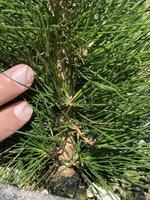
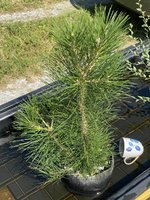
RJG2
Omono
1/8th tsp fulvic acid powder:1/16th tsp kelp powder.
Virginia tech supposedly did a 10 year experiment and found this ratio to work 50% better than either product on its own.
Very good as daily root drench with your fertilizer or once a week with foliar…….black humic powder is good for roots too in this ratio.Fulvic is a low moleculer weight humic acid that can transport growth elements or ions into plant cells whereas the larger moleculer weight black humic acid powder is a great chelator meaning it hold onto growth elements or ions like a claw more or less…….near to the roots and keeps ion from leaching out with watering.
It has been said if your only going to use one bio-stimulant…..kelp is the one.
Fulvic is the choice for foliar as it is small enough to carry elements into leaf cells in as little as 4 hours it has been scientifically noted.
Black humic is also a wonderful filler for pure and ro type water as it puts mineral back into pure water that would otherwise draw ions right out of the roots and have a negative effect….namely in hydroponic inert media.
What brand fulvic acid are you using nowadays?
Maiden69
Masterpiece
He was the one that suggested I use RAW products, the measurements he gave above are the RAW Kelp/Full Up measurements.What brand fulvic acid are you using nowadays?
RJG2
Omono
I have humic and kelp from NPK industries, but I don't see fulvic in their product listings.He was the one that suggested I use RAW products, the measurements he gave above are the RAW Kelp/Full Up measurements.
Unless that's what Full Up is, not much of a description on their site.
RJG2
Omono
I have humic and kelp from NPK industries, but I don't see fulvic in their product listings.
Unless that's what Full Up is, not much of a description on their site.
Looks like Amazon has more info. Says it's 10% fulvic acid. Wonder what the other 90% is.
Maiden69
Masterpiece
That's the one I use, I was using their Humic, but I did noticed a difference when I changed to Full Up.
NPK website is not working for me now, but here is another with an explanation of the similarities and differences. I still use humic, as it has a lot of benefits. I have been adding humic in one way or another to my lawn for years now.
Short blurb from a scholar article - Link if you feel like reading more
A little more in-depth...

 chembioagro.springeropen.com
chembioagro.springeropen.com
NPK website is not working for me now, but here is another with an explanation of the similarities and differences. I still use humic, as it has a lot of benefits. I have been adding humic in one way or another to my lawn for years now.
Short blurb from a scholar article - Link if you feel like reading more
In turn, humic substances (HSs) are constituent fractions of the organic matter of soil and are highly complex and biologically active (Canellas and Olivares, 2014). These substances include humic acids (HA), fulvic acids (FA), and humin (Schnitzer, 1978). HSs are known to stimulate the root system and plant growth and to mitigate stress damage; their effects extend to soil properties and microbial community structure (Puglisi et al., 2013; Canellas and Olivares, 2014). The action of HSs in the biological activation of plant growth is closely related to their chemical composition (Martinez-Balmori et al., 2014; García et al., 2019). The effect on plant growth of these substances depends on the mode of application of HSs to the plant, content of bioactive molecules, source, dose and molecular weight of the humic fraction, and plant species (Canellas et al., 2010; Nardi et al., 2021). HSs act on the root system, stimulating the quantity and length of lateral roots and root hairs. This process is apparently mediated by HSs in signaling pathways that involve different plant hormones. In addition, HSs play a role in the primary metabolism of plants, acting on the C and N cycles. The effect of HSs on root architecture favors greater soil exploration and, consequently, greater nutrient absorption. The role of HSs in plant nutrition goes beyond the increase in plant root morphology, and these substances can form a complex with cations present in the soil, improving the uptake of nutrients such as P, Zn, and Fe by plants (Olaetxea et al., 2018; Nardi et al., 2021). Furthermore, they are able to affect the expression of nutrient transporters, allowing greater absorption of these elements by plants, in addition, HS may increase the exudation of organic acids from the root, and favoring plant interactions with beneficial microorganisms such as PGPB (Olivares et al., 2017; Nardi et al., 2021). HSs also have the ability to alter secondary plant metabolism, affecting plant genetic expression and inducing the synthesis of compounds that help plants against biotic and abiotic stress (Canellas et al., 2015b; Giovanardi et al., 2016). Salinity and water restriction are the most studied stresses under greenhouse and field conditions, and HSs provide better responses in several agronomic crops against these stresses. The priming effect of HA in corn was generate a decrease in negative impacts of stressors on this plant (Canellas et al., 2020). The action of HSs on the protection of plants against pathogens was documented, and studies have shown that HSs can increase the plant defense system against harmful microorganisms, directly acting in the inhibition of these organisms or inducing the growth of microorganisms with antagonistic action to the pathogen, thus allowing greater protection for the plant (Jindo et al., 2020; Pereira et al., 2021).
A little more in-depth...

Incorporation of humic-derived active molecules into compound NPK granulated fertilizers: main technical difficulties and potential solutions - Chemical and Biological Technologies in Agriculture
Numerous studies carried out both in open field and laboratory scale have provided experimental evidence for a beneficial action of humic substances (HS) on plant growth and mineral nutrition. In fact, many products containing diverse concentrations of humic substances, mainly humic and fulvic...
luvinthemountains
Chumono
1/8th tsp fulvic acid powder:1/16th tsp kelp powder.
Virginia tech supposedly did a 10 year experiment and found this ratio to work 50% better than either product on its own.
Very good as daily root drench with your fertilizer or once a week with foliar…….black humic powder is good for roots too in this ratio.Fulvic is a low moleculer weight humic acid that can transport growth elements or ions into plant cells whereas the larger moleculer weight black humic acid powder is a great chelator meaning it hold onto growth elements or ions like a claw more or less…….near to the roots and keeps ion from leaching out with watering.
It has been said if your only going to use one bio-stimulant…..kelp is the one.
Fulvic is the choice for foliar as it is small enough to carry elements into leaf cells in as little as 4 hours it has been scientifically noted.
Black humic is also a wonderful filler for pure and ro type water as it puts mineral back into pure water that would otherwise draw ions right out of the roots and have a negative effect….namely in hydroponic inert media.
I am in for two seedlings, just placed my order last night. Around December, they will go into my shed kept at 32F-35F. Not that they will need it, but I will have a 4x4 T5 light in there as well, for some of my warmer-zone evergreens.
I read a little bit on the NPK Indus products. Interesting, for their all-in-one Grow fert they don't recommend much Full Up at all. I might just buy a bucket of Grow and use it in conjunction with cal-mag to keep it simple. If I get an RO filter, I will probably throw in the humic, too. So I have a 100gal rain barrel I plan to use for adjusting either tap or RO water to acceptable Ph levels next year. Would you recommend adding the humic and cal-mag all at once and just letting it sit in the barrel until used?
Similar threads
- Replies
- 0
- Views
- 112
- Replies
- 6
- Views
- 167
- Replies
- 2
- Views
- 211


